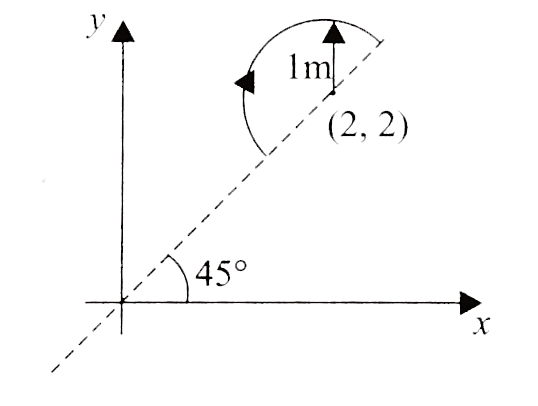A uniform magnetic field existsin region given by →B=3ˆi+4ˆj+5ˆk. A rod of length 5m is placed along y-axis is moved along x- axis with constant speed 1m/sec. Then the magnitude of induced e.m.f in the rod is :
zero
25V
20V
15V
The correct Answer is:B
To solve the problem, we need to find the magnitude of the induced electromotive force (e.m.f) in a rod moving through a magnetic field. Here are the steps to arrive at the solution:
Step 1: Identify the given quantities
- The magnetic field vector is given as:
→B=3^i+4^j+5^kT
- The length of the rod is:
L=5m
- The rod is placed along the y-axis, so its vector representation is:
→L=5^jm
- The speed of the rod moving along the x-axis is:
→v=1^im/s
Step 2: Use the formula for induced e.m.f
The induced e.m.f (E) in the rod can be calculated using the formula:
E=→L⋅(→v×→B)
Step 3: Calculate the cross product →v×→B
First, we need to compute the cross product →v×→B:
→v=1^i
→B=3^i+4^j+5^k
Using the determinant method for the cross product:
→v×→B=∣∣
∣
∣∣^i^j^k100345∣∣
∣
∣∣
Calculating this determinant:
=^i(0⋅5−0⋅4)−^j(1⋅5−0⋅3)+^k(1⋅4−0⋅3)
=0^i−5^j+4^k
=−5^j+4^k
Step 4: Calculate the dot product →L⋅(→v×→B)
Now, we compute the dot product:
→L=5^j
→v×→B=−5^j+4^k
→L⋅(→v×→B)=(5^j)⋅(−5^j+4^k)
Calculating the dot product:
=5⋅(−5)+0=−25
Step 5: Find the magnitude of the induced e.m.f
The magnitude of the induced e.m.f is:
|E|=|−25|=25V
Final Answer
Thus, the magnitude of the induced e.m.f in the rod is:
E=25V
---
- The magnetic field vector is given as:
→B=3^i+4^j+5^kT
- The length of the rod is:
L=5m
- The rod is placed along the y-axis, so its vector representation is:
→L=5^jm
- The speed of the rod moving along the x-axis is:
→v=1^im/s
The induced e.m.f (E) in the rod can be calculated using the formula:
E=→L⋅(→v×→B)
First, we need to compute the cross product →v×→B:
→v=1^i
→B=3^i+4^j+5^k
→v×→B=∣∣
∣
∣∣^i^j^k100345∣∣
∣
∣∣
=^i(0⋅5−0⋅4)−^j(1⋅5−0⋅3)+^k(1⋅4−0⋅3)
=0^i−5^j+4^k
=−5^j+4^k
Now, we compute the dot product:
→L=5^j
→v×→B=−5^j+4^k
→L⋅(→v×→B)=(5^j)⋅(−5^j+4^k)
Calculating the dot product:
=5⋅(−5)+0=−25
The magnitude of the induced e.m.f is:
|E|=|−25|=25V
Thus, the magnitude of the induced e.m.f in the rod is:
E=25V
Topper's Solved these Questions
Similar Questions
The magnetic field in a region is given by →B=B0(1+xa)ˆk. A square loop of edge length 'd' is placed with its edge along X-axis and Y-axis. The loop is moved with a constant velocity →V=V0ˆi. The emf induced in the loop is
View SolutionWhat is the length of projection of →A=3ˆi+4ˆj+5ˆk on xy plane ?
View SolutionA vector is given by →A=3ˆi+4ˆj+5ˆk. Find the magnitude of →A , unit vector along →A and angles made by →A with coordinate axes.
View SolutionMagnetic force on a charged particle is given by →Fm=q(→v×→B) and electrostatic force →Fe=q→E. A particle having charge q = 1C and mass 1 kg is released from rest at origin. There are electric and magnetic field given by →E=(10ˆi)N/Cforx=1.8m and →B=−(5ˆk)T for 1.8m≤x≤2.4m
A screen is placed parallel to y-z plane at x=3m. Neglect gravity forces.
The speed with which the particle will collide the screen is
View SolutionA uniform magnetic field →B=3ˆi+4ˆj+ˆk exists in region of space. A semicircular wire of radius of 1 m carrying current 1 A having its centre at (2, 2, 0) is placed in x-y plane as shown in Fig. The force on semicircular wire will be

View SolutionA uniform magnetic field →B=3ˆi+4ˆj+ˆk exists in region of space. A semicircular wire of radius of 1 m carrying current 1 A having its centre at (2, 2, 0) is placed in x-y plane as shown in Fig. The force on semicircular wire will be

View SolutionThe compenent of →A=ˆi+ˆj+5ˆk perpendicular to →B=3ˆi+4ˆj is
View SolutionA charged particle with charge to mass ratio (qm)=(10)319Ckg−1 enters a uniform magnetic field →B=20ˆi+30ˆj+50ˆkT at time t = 0 with velocity →V=(20ˆi+50ˆj+30ˆk)m/s. Assume that magnetic field exists in large space.
During the further motion of the particle in the magnetic field, the angle between the magnetic field and velocity of the particle
View SolutionA particle is moving with speed 6m/s along the direction of →A=2ˆi+2ˆj−ˆk, then its velocity is :
View SolutionGiven two vectors →A=−ˆi+2ˆj−3ˆk and →B=4ˆi−2ˆj+6ˆk. The angle made by (A+B) with x-axis is :
View Solution
